Leica MZ16 FA, MZ6, MZ95, MZ75, MS5 User Manual
...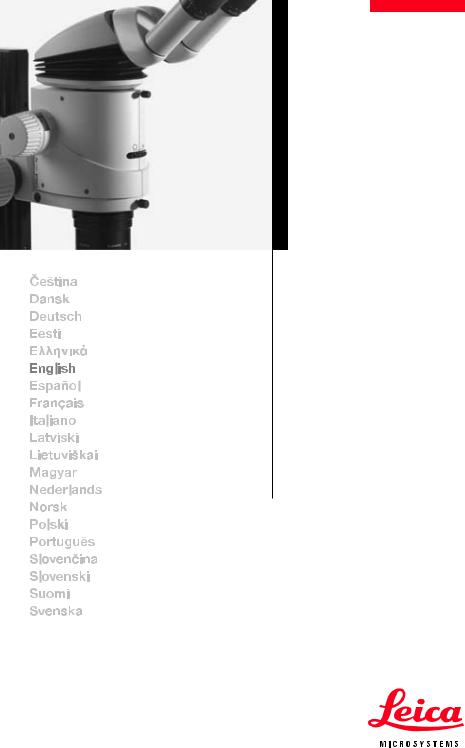
Leica M Stereo-
microscopes
User Manual

Dear User
Thank you for choosing our products. We hope that you will enjoy the quality and performance of Leica Microsystems products.
In developing our instruments, we have placed great emphasis on simple, self-explanatory directions. In order to utilize all the benefits of your new stereomicroscope, we suggest studying this user manual in detail. Should you have any questions, please consult your local Leica representative. You will find the address of the closest local representative as well as valuable information about products and services from Leica Microsystems on our homepage at www.leica-microsystems.com
We are gladly at your service. Customer service is a big thing with us. Not only before the sale, but afterwards as well.
Leica Microsystems (Switzerland) Ltd Stereo & Macroscope Systems www.stereomicroscopy.com
User Manual
Your instrument is accompanied by a printed English user manual. Additional language versions and information can be found on the interactive CD-ROM. User manuals and updates are available for download on our homepage at www.stereomicroscopy.com.
This user manual contains an explanation of the safety regulations, assembly, handling and accessories of the Leica MS5, MZ6, MZ75, MZ95, MZ125, MZ16, MZ16 A and MZ16 FA
(if identical) stereomicroscopes. The special functions of the automated stereomicroscopes Leica MZ16 A and MZ16 FA can be found in separate user manuals.
Leica M Stereomicroscopes User Manual |
3 |
Table of contents
Page
Overview
Safety concept . . . . . . . . . . . . . . . . . . . . . . . . . . . . . . . . . . . . . . . . . . 6
Symbols . . . . . . . . . . . . . . . . . . . . . . . . . . . . . . . . . . . . . . . . . . . . . . . . 9
Controls and functions . . . . . . . . . . . . . . . . . . . . . . . . . . . . . . . . . . 10
Use
Changing the magnification . . . . . . . . . . . . . . . . . . . . . . . . . . . . . . 12
Ergonomics . . . . . . . . . . . . . . . . . . . . . . . . . . . . . . . . . . . . . . . . . . . . 14
Interpupillary distance . . . . . . . . . . . . . . . . . . . . . . . . . . . . . . . . . . 15
Eyepoint . . . . . . . . . . . . . . . . . . . . . . . . . . . . . . . . . . . . . . . . . . . . . . 15
Eye contact, eyecups . . . . . . . . . . . . . . . . . . . . . . . . . . . . . . . . . . . 16
Focusing . . . . . . . . . . . . . . . . . . . . . . . . . . . . . . . . . . . . . . . . . . . . . . 16
Microscope carrier: Stereoscopic and axial observation . . . . 18
Diopter settings . . . . . . . . . . . . . . . . . . . . . . . . . . . . . . . . . . . . . . . . 20
Assembly
Overview: Components . . . . . . . . . . . . . . . . . . . . . . . . . . . . . . . . . . 22
Stand
Profile column for incident light and transmitted-light stands . . 23
Transmitted-light stand, bright field, 20 W . . . . . . . . . . . . . . . . . . 23
Transmitted-light stand, bright and dark field . . . . . . . . . . . . . . . 26
Transmitted-light stand HL . . . . . . . . . . . . . . . . . . . . . . . . . . . . . . . 27
Swinging-arm stand ESD . . . . . . . . . . . . . . . . . . . . . . . . . . . . . . . . 28
Large swinging-arm and table-clamp stands . . . . . . . . . . . . . . . 30
Optics carrier, optical accessories
Spacer rings, objective combinations . . . . . . . . . . . . . . . . . . . . . 32
Microscope carrier . . . . . . . . . . . . . . . . . . . . . . . . . . . . . . . . . . . . . 34
Optics carrier . . . . . . . . . . . . . . . . . . . . . . . . . . . . . . . . . . . . . . . . . . 34
Binocular tubes, optical accessories . . . . . . . . . . . . . . . . . . . . . . 35
Objective nosepiece (MZ16 and MZ16 A) . . . . . . . . . . . . . . . . . . 36
4 |
Leica M Stereomicroscopes User Manual |

Page
Illuminators
Transformers . . . . . . . . . . . . . . . . . . . . . . . . . . . . . . . . . . . . . . . . . . . 38 Incident lamp 6 V/10 W . . . . . . . . . . . . . . . . . . . . . . . . . . . . . . . . . . 40 Incident lamp 6 V/20 W . . . . . . . . . . . . . . . . . . . . . . . . . . . . . . . . . . 42 Cold light sources . . . . . . . . . . . . . . . . . . . . . . . . . . . . . . . . . . . . . . 45 Fiber-optic light guide . . . . . . . . . . . . . . . . . . . . . . . . . . . . . . . . . . .46 LED illumination . . . . . . . . . . . . . . . . . . . . . . . . . . . . . . . . . . . . . . . . 46 Supply (line) lamp 25 W . . . . . . . . . . . . . . . . . . . . . . . . . . . . . . . . . 47 Coaxial illuminator . . . . . . . . . . . . . . . . . . . . . . . . . . . . . . . . . . . . . . 47 Near-vertical illuminator . . . . . . . . . . . . . . . . . . . . . . . . . . . . . . . . . 48
Accessories
Fitting accessory tubes . . . . . . . . . . . . . . . . . . . . . . . . . . . . . . . . . . 50 Double-iris diaphragm . . . . . . . . . . . . . . . . . . . . . . . . . . . . . . . . . . 50 Drawing tube, discussion tube . . . . . . . . . . . . . . . . . . . . . . . . . . . 51 Video/phototubes:
Photography, video, TV, filming, digital imaging . . . . . . . . . . . . . 52 Attachment for vertical and oblique observation . . . . . . . . . . . . 56 Graticules . . . . . . . . . . . . . . . . . . . . . . . . . . . . . . . . . . . . . . . . . . . . . 56 Stages, polarization . . . . . . . . . . . . . . . . . . . . . . . . . . . . . . . . . . . . . 57
Special notes
Tips and hints: What to do if . . . . . . . . . . . . . . . . . . . . . . . . . . . . . . 58 Care and maintenance . . . . . . . . . . . . . . . . . . . . . . . . . . . . . . . . . . 59 Calculating total magnification and field
of view diameter . . . . . . . . . . . . . . . . . . . . . . . . . . . . . . . . . . . . . . . 61 Optical data for MS5, MZ6 . . . . . . . . . . . . . . . . . . . . . . . . . . . . . . . 62 Optical data for MZ75, MZ95 . . . . . . . . . . . . . . . . . . . . . . . . . . . . . 64 Optical data for MZ125, MZ16, MZ16 A . . . . . . . . . . . . . . . . . . . . 66 Dimensions . . . . . . . . . . . . . . . . . . . . . . . . . . . . . . . . . . . . . . . . . . . . 67 Technical data electronical devices . . . . . . . . . . . . . . . . . . . . . . .74
Leica M Stereomicroscopes User Manual |
5 |
Safety concept
General directions Read the user manual and safety instructions before starting up.
Permitted uses The Leica MS5, MZ6, MZ75, MZ95, MZ125, MZ16 and MZ16 A stereomicroscopes are optical instruments which use magnification for improved visualization of objects, their details and specimens from technology and natural sciences. The basic outfit, which includes a stand and a light source, can be supplemented with various modules for photography, TV, dual station viewing and other applications.
Prohibited • The use of the instrument in a different manner from that described in uses this user manual can lead to injury, malfunction and damage.
•The Leica MS5, MZ6, MZ75, MZ95, MZ125, MZ16 and MZ16 A stereomicroscopes must not be used for eye examinations and operations.
•Do not fit different plugs. Do not dismantle optical systems or mechanical parts unless instructions for doing so are given in the user manual.
Place • The Leica MS5, MZ6, MZ75, MZ95, MZ125, MZ16 and MZ16 A stereo- of use microscopes are intended mainly for indoor use.
•If the stereomicroscope is used outdoors, protect it from dirt and moisture. Lamps and electrically-operated stands from Leica may not be used outdoors.
Use in ESD The optics carriers MS5, MZ6, MZ75, MZ95, MZ125, MZ16 and MZ16 A, the protected rooms binocular tube, ErgoTube™, ErgoWedge™ 5°–25°, the swinging-arm
stand ESD and the cold light sources Leica L2 and CLS consist of ESDdischarging material (surface resistance <1011 ohms/squared, discharge time <2 seconds, 1,000 V to 100 V).
–A connection socket for a 4 mm grounding cable is provided on the microscope carrier.
–There are two connection sockets for 4 mm grounding cables in the base of the swinging-arm stand.
Use in Clean Rooms The Leica M series can be used in clean rooms without any problems and they can be cleaned as described on page 60. Please observe the following rules:
–Do not clean our stereomicroscopes and accessories in a different manner from that described in this user manual. Do not use unsuitable cleaning agents, chemicals and techniques. Do not clean painted surfaces and accessories with rubber parts such as the ErgoTube® 10° – 50° with chemicals.
This can damage the surfaces. Particles or grindings can contaminate the specimen.
–If the customer cleans our instruments with chemicals without our written approval he will do it at his own risk.
–In most cases we can offer special solutions on request. Some products can be modified or we could recommend other accessories for use in clean rooms.
6 |
Leica M Stereomicroscopes – Safety concept |
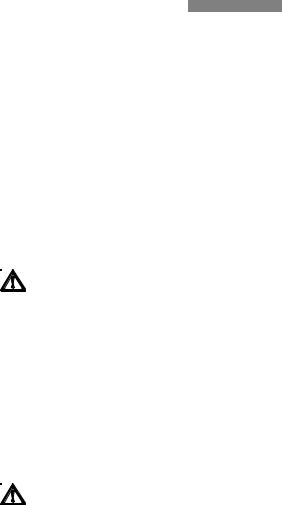
Safety regulations
Servicing |
Repairs may only be carried out by Leica-trained service tech- |
|
nicians. |
|
Only original Leica spare parts may be used. |
Responsibilities |
• Ensure that personnel who use the instrument have read and |
of person in charge |
understood this user manual and in particular the safety |
of instrument |
instructions. |
|
• Ensure that the Leica MS5, MZ6, MZ75, MZ95, MZ125, MZ16 |
|
and MZ16 A stereomicroscopes are operated, maintained |
|
and repaired only by |
|
authorized and trained personnel. |
Workplaces with stereomicroscopes facilitate and improve the viewing task, but they also impose high demands on the eyes and holding muscles of the user. Dependent upon the duration of uninterrupted activity, this may lead to asthenic trouble and muscular-skeletal pain so that suitable measures must be taken to reduce the strain:
–perfect design of workplace (see p.14), work content and work process (frequently changing activities).
–detailed introduction of the personnel while considering ergonomic and organizational work-related aspects.
The ergonomic optics concept and the design of the Leica M series aim at limiting the strain on the user to the lowest possible level.
Direct contact with eyepieces can be a potential transmission path for bacterial and viral infections of the eye. Users should be made aware of the potential risk of infection. The risk can be kept at a minimum by using individual eyepieces or attachable eyecups (see p.16).
Leica M Stereomicroscopes – Safety regulations |
7 |
Electrically-operated items
The safety regulations listed below apply to the following items:
–Transmitted-light stand, bright field, 20 W (page 24)
–Supply (line) lamp 25 W (page 47)
–Regulating transformer 0–7 V/40 W (page 38)
–Step transformer 4/5/6 V (page 39)
–Motor focus (separate instructions)
–Motorized Leica MZ16 A
Liquids Be careful when handling liquids.
If spilt on the equipment, they can:
–cause the stereomicroscopes and accessories to become electrically live, endangering personnel,
–cause damage to the equipment.
Power cables Inspect cables regularly for damage. Defective cables can:
–directly endanger personnel,
–cause the stereomicroscopes and accessories to become electrically live, endangering personnel.
Cable routing Route cables with care. Make sure that personnel do not get entangled with them. The instrument could fall over, fall down, become damaged, damage other equipment, or cause personal injury.
Opening the instrument Only authorized Leica personnel are permitted to repair electrical equipment. Before opening up the equipment, pull out the power cable. If you touch the live interior of the equipment, you may receive an electric shock.
Supply voltage Ensure that the voltage setting on the equipment is correct. A wrong setting can cause damage to the equipment.
Connections When connecting power-consuming devices to the transformers, do not exceed the maximum permitted loading, as this can cause damage to the equipment.
Changing bulbs • Before changing a bulb, disconnect the power cable.
•Never attempt to touch the inside of a lamp housing or transmitted-light stand while the instrument is connected to the power supply.
•Before changing a bulb, wait until it is cool, otherwise you may burn your fingers.
8 |
Leica M Stereomicroscopes – Safety regulations |
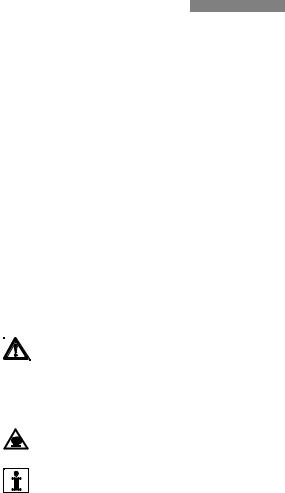
Integration in The following must be observed if Leica products are build into third-party products third-party products:
The manufacturer of the complete system or the person putting it on the market is responsible for adhering to applicable safety regulations, laws and guidelines.
Legal requirements Adhere to general and local regulations relating to accident prevention and environmental protection.
Disposal The products described here must be disposed off in accordance with applicable local laws and regulations.
Conformity with The electrically-operated accessories for the Leica MS5, MZ6, European Community MZ75, MZ95, MZ125, MZ16 and MZ16 A stereomicroscopes are
directive constructed in accordance with the latest technologies and provided with a statement of conformity with EC requirements.
Symbols used in this user manual
Safety instructions
This symbol denotes information which must be read and obeyed. Non-observance
–can put personnel at risk!
–can cause malfunctioning or damage to the equipment.
Warning about accessible hot places, e.g. bulbs.
Failure to respect it can cause burns!
Important information
This symbol denotes additional information or explanations which promote understanding.
Action
This symbol within the text indicates that certain operations must be carried out.
Explanatory notes
•This symbol within the text stands for additional information and explanations.
Leica M Stereomicroscopes – Safety regulations |
9 |
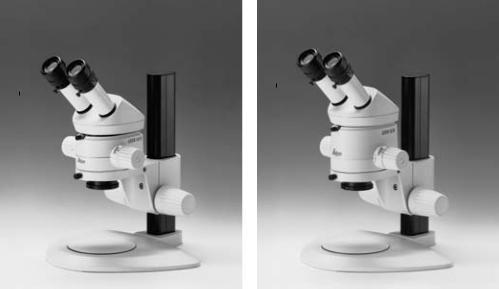
Overview
Stereomicroscope |
Binocular tube |
|||||||||||||||||||||||||
1 |
Magnification changer |
7 |
Adjustable eyepiece tubes |
|||||||||||||||||||||||
2 |
Engaging ratchet positions |
|
Interpupillary distance adjustable from |
|||||||||||||||||||||||
|
52 mm – 76 mm. |
|||||||||||||||||||||||||
3a |
Focusing drive |
|
||||||||||||||||||||||||
8 |
Wide-field eyepieces for persons wearing |
|||||||||||||||||||||||||
|
|
|
|
|
|
|
|
|
|
|
|
|||||||||||||||
3b |
Coarse and fine focusing |
|
glasses |
|||||||||||||||||||||||
|
Larger knob: Coarse focusing, |
|
Diopter setting adjustable within the range |
|||||||||||||||||||||||
|
Smaller knob: Fine focusing. |
|
from +5 to –5, and eyecups adjustable. |
|||||||||||||||||||||||
3c |
Adjustable ring |
9 |
Clamping screws |
|||||||||||||||||||||||
|
Changes the ease of movement |
|
These hold the eyepieces in the |
|||||||||||||||||||||||
|
of the coarse/fine drive. |
|
binocular tube. |
|||||||||||||||||||||||
4 |
Clamping screw |
10 |
ErgoTube™ |
|||||||||||||||||||||||
|
Holds the optics carrier in the |
|
The viewing angle is adjustable within the |
|||||||||||||||||||||||
|
microscope carrier. |
|
range 10° – 50°. |
|||||||||||||||||||||||
5 |
Clamping screw |
11 |
Built-in double-iris diaphragm |
|||||||||||||||||||||||
|
Holds the binocular tube (or accessory) |
|
(MZ16/MZ16 A only) |
|||||||||||||||||||||||
|
to the optics carrier. |
• |
The special functions of the Leica MZ16 A are |
|||||||||||||||||||||||
|
|
|
|
|
|
|
|
|
|
|
|
|||||||||||||||
6 |
Interchangeable objective |
|
shown in the user manual M2-116-0. |
|||||||||||||||||||||||
|
Achromatic, planachromatic or planapochromatic |
|
|
|
|
|
|
|
|
|
|
|
|
|
|
|||||||||||
Leica MS5 |
Leica MZ6 |
|||||||||||||||||||||||||
8 |
|
|
|
|
|
|
|
|
|
|
|
8 |
|
|
|
|
|
|
|
|
|
|
|
|
|
|
|
|
|
|
|
|
|
|
|
|
|
|
|
|
|
|
|
|
|
|
|
|
|
|
|||
9 |
|
|
|
|
|
|
|
|
|
|
|
9 |
|
|
|
|
|
|
|
|
|
|
|
|
|
|
|
|
|
|
|
|
|
|
|
|
|
|
|
|
|
|
|
|
|
|
|
|
|
|
|||
|
|
|
|
|
|
|
|
|
|
|
|
|
|
|
|
|
|
|
|
|
|
|
|
|||
|
|
|
|
|
|
|
|
|
|
|
7 |
|
|
|
|
|
|
|
|
|
|
|
|
|
||
|
|
|
|
|
|
|
|
|
|
|
|
|
|
|
|
|
|
|
|
|
|
|
|
|||
7 |
|
|
|
|
|
|
|
|
|
|
|
|
|
|
|
|
|
|
|
|
|
|
|
|
||
|
|
|
|
|
|
|
|
|
|
|
5 |
|
|
|
|
|
|
|
|
|
|
|
|
|
||
|
|
|
|
|
|
|
|
|
|
|
|
|
|
|
|
|
|
|
|
|
|
|
|
|||
|
|
|
|
|
|
|
|
|
|
|
|
|
|
|
|
|
|
|
|
|
|
|
|
|||
5 |
|
|
|
|
|
|
|
|
|
1 |
|
|
|
|
|
|
|
|
|
|
|
|
1 |
|||
|
|
|
|
|
|
|
|
|
|
|
|
|
|
|
|
|
|
|
|
|
||||||
|
|
|
|
|
|
|
|
|
|
|
|
|
|
|
|
|
|
|
|
|
|
|||||
|
|
|
|
|
|
|
|
|
|
|
|
|
|
|
|
|
|
|
|
|
|
|||||
4 |
|
|
|
|
|
|
4 |
|
|
|
|
|
|
|
|
|
||||||||||
|
|
|
|
|
|
|
|
|
|
|
|
|
|
|
||||||||||||
|
|
|
|
|
|
|
|
|
|
|
||||||||||||||||
|
|
|
|
|
|
|
|
|
|
|
|
|
|
|
|
|
|
2 |
||||||||
6 |
|
|
|
|
|
|
|
|
|
|
3a |
6 |
|
|
|
|
|
|
|
|
|
|
|
|
3a |
|
|
|
|
|
|
|
|
|
|
|
|
|
|
|
|
|
|
|
|
|
|
|
|||||
|
|
|
|
|
|
|
|
|
|
|
|
|
|
|
|
|
|
|
|
|
|
|
|
|||
|
|
|
|
|
|
|
|
|
|
|
|
|
|
|
|
|
|
|
|
|
|
|
|
|||
10 |
Leica M Stereomicroscopes – Overview |
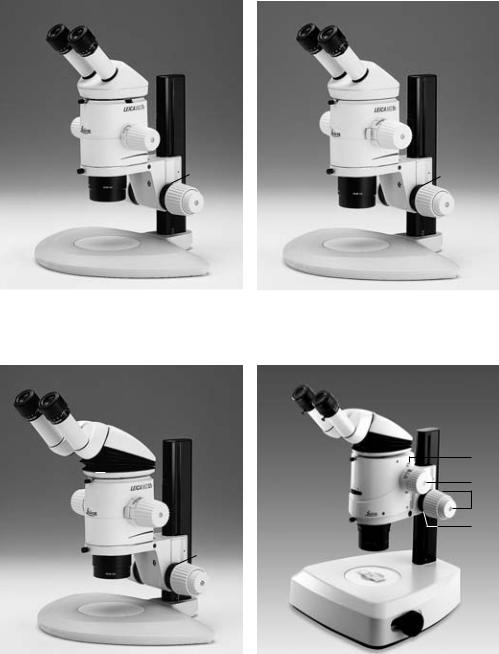
Leica MZ75 |
|
|
|
|
|
|
|
Leica MZ95 |
|
|
|
|
|
|
|
|
||||||||||
|
|
|
|
|
|
|
|
|
|
|
|
|
|
|
||||||||||||
8 |
|
|
|
|
|
|
|
|
|
|
|
|
|
8 |
|
|
|
|
|
|
|
|
|
|
|
|
|
|
|
|
|
|
|
|
|
|
|
|
|
|
|
|
|
|
|
|
|
|
|
|
|
||
7 |
|
|
|
|
|
|
|
|
|
|
|
|
2 |
7 |
|
|
|
|
|
|
|
|
|
|
|
|
|
|
|
|
|
|
|
|
|
|
|
|
|
|
|
|
|
|
|
|
|
|
|
|
|||
|
|
|
|
|
|
|
|
|
|
|
|
|
|
|
|
|
|
|
|
|
|
|
|
|||
5 |
|
|
|
|
|
|
|
|
|
|
|
|
5 |
|
|
|
|
|
|
|
|
|
|
|
|
|
|
|
|
|
|
|
|
|
|
|
|
|
|
|
|
|
|
|
|
|
|
|
|
||||
4 |
|
|
|
|
|
|
|
|
|
|
|
1 |
4 |
|
|
|
|
|
|
|
|
|
|
|
|
|
|
|
|
|
|
|
|
|
|
|
|
|
|
|
|
|
|
|
|
|
|
|
|||||
|
|
|
|
|
|
|
|
|
|
|
|
3c |
|
|
|
|
|
|
|
|
|
|
|
|
||
|
|
|
|
|
|
|
|
|
|
|
|
|
|
|
|
|
|
|
|
|
|
|
|
|||
|
|
|
|
|
|
|
|
|
|
|
|
|
|
|
|
|
|
|||||||||
|
|
|
|
|
|
|
|
|
|
|
|
|
|
|
|
|
|
|
|
|
|
|
|
|||
6 |
|
|
|
|
|
|
|
|
|
|
|
|
3b |
6 |
|
|
|
|
|
|
|
|
|
|
|
|
|
|
|
|
|
|
|
|
|
|
|
|
|
|
|
|
|
|
|
|
|
|
|
|
|||
|
|
|
|
|
|
|
|
|
|
|
|
|
|
|
|
|
|
|
|
|
|
|
|
|||
|
|
|
|
|
|
|
|
|
|
|
|
|
|
|
|
|
|
|
|
|
|
|
|
|
|
|
|
|
|
|
|
|
|
|
|
|
|
|
|
|
|
|
|
|
|
|
|
|
|
|
|
|
|
Leica design
by Ernest Igl/Christophe Apothéloz
Leica MZ125 |
|
|
|
|
|
|
|
|
|
|
|
Leica MZ16 |
|
|
|
|
|
|
|||||||
8 |
|
|
|
|
|
|
|
|
|
|
|
|
|
|
|
8 |
|
|
|
|
|
|
|
|
|
|
|
|
|
|
|
|
|
|
|
|
|
|
|
|
|
|
|
|
|
|
|
|
|
||
|
|
|
|
|
|
|
|
|
|
|
|
|
|
|
|
9 |
|
|
|
|
|
|
|
|
|
|
|
|
|
|
|
|
|
|
|
|
|
|
|
|
|
|
|
|
|
|
|
|
|
|
|
|
|
|
|
|
|
|
|
|
|
|
|
|
|
|
|
|
|
|
|
|
|
|
|
|
|
7 |
|
|
|
|
|
|
|
|
|
|
|
|
|
|
|
7 |
|
|
|
|
|
|
|
|
|
|
|
|
|
|
|
|
|
|
|
|
|
|
|
|
|
|
|
|
|
|
|
|
|||
|
|
|
|
|
|
|
|
|
|
|
|
|
|
|
10 |
|
|
|
|
|
|
|
|
|
|
|
|
|
|
|
|
|
|
|
|
|
|
|
|
|
|
|
|
|
|
|
|
|
|
|
|
|
|
|
|
|
|
|
|
|
|
|
|
|
|
|
|
|
|
|
|
|
|
|
|
|
|
10 |
|
|
|
|
|
|
|
|
|
|
|
|
|
|
|
5 |
|
|
|
|
|
|
|
|
|
|
|
|
|
|
|
|
|
|
|
|
|
|
|
|
|
|
|
|
|
|
|
|
|
||
|
|
|
|
|
|
|
|
|
|
|
|
|
|
|
|
|
|
|
|
|
|
|
|
|
|
5 |
|
|
|
|
|
|
|
|
|
|
|
|
|
1 |
11 |
|
|
|
|
|
|
|
|
|
|
|
|
|
|
|
|
|
|
|
|
|
|
|
|
|
|
|
|
|
|
|
|
||||
|
|
|
|
|
|
|
|
|
|
|
|
|
|
|
|
|
|
|
|
|
|
|
|||
|
|
|
|
|
|
|
|
|
|
|
|
|
|
|
|
|
|
|
|
|
|
|
|||
|
|
|
|
|
|
|
|
|
|
|
4 |
|
|
|
|
|
|
|
|
|
|||||
|
|
|
|
|
|
|
|
|
|
|
|
|
|
|
|
|
|
|
|
||||||
|
|
|
|
|
|
|
|
|
|
|
|
|
|
|
|
|
|
||||||||
|
|
|
|
|
|
|
|
|
|
|
|
|
|
2 |
|
|
|
|
|
|
|
|
|
||
4 |
|
|
|
|
|
|
|
|
|
|
6 |
|
|
|
|
|
|
|
|
|
|||||
|
|
|
|
|
|
|
|
|
|
|
|
|
|
3c |
|
|
|
|
|
|
|
|
|
||
|
|
|
|
|
|
|
|
|
|
|
|
|
|
|
|
|
|
|
|
|
|
|
|||
|
|
|
|
|
|
|
|
|
|
|
|
|
|
|
|
|
|
|
|
|
|
|
|
||
|
|
|
|
|
|
|
|
|
|
|
|
|
|
|
|
|
|
|
|
|
|
|
|
||
6 |
|
|
|
|
|
|
|
|
|
|
|
|
|
|
|
|
|
|
|
|
|
|
|
|
|
|
|
|
|
|
|
|
|
|
|
|
|
|
|
3b |
|
|
|
|
|
|
|
|
|
|
|
|
|
|
|
|
|
|
|
|
|
|
|
|
|
|
|
|
|
|
|
|
|
|
|
|
|
|
|
|
|
|
|
|
|
|
|
|
|
|
|
|
|
|
|
|
|
|
|
|
|
|
|
1
2
3c
3b
2
1
3b
3c
Leica M Stereomicroscopes – Overview |
11 |

Use
Magnification changer
•Zoom means continuous change of magnification. Ratchets can be engaged for certain magnifications (see below).
•For zooming with MZ16 A, see the user manual M2-116-0.
MS5: 5 steps
MZ6: 6:1 zoom
MZ75: 7.9:1 zoom
MZ95: 9.5:1 zoom
MZ125: 12.5:1 zoom
MZ16 and MZ16 A: 16:1 zoom
Changing the • The magnification changer can be operated from either magnification the right or the left side.
Look into the eyepieces.
Focus on the object (page 16).
Turn the magnification changer to the desired position.
Ratchet steps MZ6: 0.8, 1, 1.25, 1.6, 2, 2.5, 3.2
MZ75: 0.8, 1, 1.25, 1.6, 2, 2.5, 3.2, 4
MZ95: 0.8, 1, 1.25, 1.6, 2, 2.5, 3.2, 4, 5
MZ125: 1, 1.25, 1.6, 2, 2.5, 3.2, 4, 5, 6.3, 8
MZ16: 0.8, 1, 1.25, 1.6, 2, 2.5, 3.2, 4, 5, 6.3, 8, 10
•Engage the ratchets whenever magnifications need to be exactly reproducible.
For MZ6, MZ95, MZ125 and
MZ16: Press the switch.
For MZ75: Turn the knurled ring counterclockwise.
For setting ratchets at the MZ16 A, see the user manual M2-116-0.
12 |
Leica M Stereomicroscopes – Operation |
|
|
|
|
Scale of |
MS5, MZ6: Display of magnification factors from 0.63–4. |
||
magnifications |
MZ75: Display of magnification factors from 0.63–5. |
||
|
Corresponding scales for other objective and eyepiece combi- |
||
|
nations can be affixed to the rotary knobs (page 34). |
||
|
MZ95: Display of magnification factors from 0.63–6. |
||
|
MZ125: Display of magnification factors from 0.8–10. |
||
|
MZ16, MZ16 A: Display of magnification factors from 0.71–11.5 |
||
|
MZ16 A: For the digital display of the magnification see the user |
||
|
manual M2-116-0. |
||
Magnifications |
The tables on pages 62 – 66 provide information about the |
||
and fields |
magnifications and field of view diameters as a function of the |
||
of view |
magnification changer position of the eyepiece-objective |
||
|
combination used. |
||
Magnification with When the MZ125/MZ16 planachromatic and planapochromatic MZ125/MZ16 objectives are used on the Leica MS5, MZ6, MZ75 and MZ95,
planachromatic and the magnification is increased by the factor 1.25× . This factor planapochromatic is taken into account in the tables.
objectives
Magnification on |
Magnification on |
MZ125/MZ16 |
MS5/MZ6/MZ75/MZ95 |
|
|
1× plan/planapo |
1.25× |
|
|
1.6× planapo |
2× |
|
|
0.63× planapo |
0.8× |
|
|
0.5× plan |
0.63× |
|
|
0.8× plan |
1× |
|
|
2× planapo |
2.5× |
|
|
Leica M Stereomicroscopes – Operation |
13 |

Ergonomics, viewing height
Preconditions for • Pay great attention when setting up your stereomicroscope. working comfortably You will only benefit fully from the outstanding optical and
ergonomic advantages of the instrument if you set it up precisely in accordance with the directions already given.
•For fatigue-free work, use the ErgoModules™.
•Arrange your workplace as well as possible, and pay attention to the heights of chair and table.
•When sitting, use the entire seat area and also the back support of the chair.
•Support your forearms.
•During work breaks, stand up and move around for exercise.
Please also observe the note on p. 7.
Ergonomics The reasons why users often cannot work comfortably with the 45° tube are the differing heights of the outfits, the various accessories and working distances, and the fact that the same instrument is often used by several people of differing builds. This problem can be effectively solved by using the Leica ErgoModules™.
If you have problems with the viewing configuration on your stereomicroscope, ask your Leica consultant for the most ergonomic Leica solutions.
Ergo objective With the achromatic Ergo objective 0.4×– 0.63× for the Leica MS5, MZ6, MZ75 and MZ95 it is possible to focus in the region of 90mm (63.5 mm – 153.5 mm) ergonomically and precisely, without changing the viewing height. At the same time, magnification and working distance can be changed without any time-consuming changing of the objectives.
Viewing height, The viewing height is correct when your head and back are viewing angle comfortably positioned.
• On the ErgoTube™, the viewing angle is adjustable from 10° – 50°.
Holding the eyepiece tubes at their bases, swing them up or down (see arrow).
14 |
Leica M Stereomicroscopes – Operation |
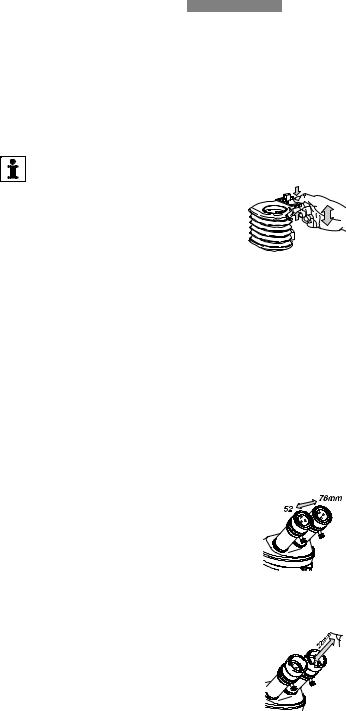
ErgoModule™ – ErgoWedge™ 5° – 25°
–ErgoWedge™ ±15°
–ErgoModule™ 50 mm
–The ErgoTube™ 45° has eyepiece tubes which are 65 mm longer than the standard ones.
Magnification factor 1.6×.
MZ16 A: The magnification factor can be toggled on and off using the OPT key.
– ErgoModule™ 30 – 120 mm Relubrication may be required after several years (please send the item to Leica Service).
Ergo objective The achromatic Ergo objective 0.4×–0.63× can be used to ergonomically and accurately focus in the range of 90 mm (63.5–153.5 mm) without changing the viewing height. At the same time, magnification and working distance can be changed without time-consuming change of objectives.
Motor focus Frequently repeated fine-motor tasks, such as focusing by hand, can lead to muscle fatigue and hand problems. Using the Leica motor focusing system, every equipment can be moved up and down without applying force.
Interpupillary distance, eye contact
Interpupillary distance The interpupillary distance is correct when you see a single circular field when viewing with both eyes.
Look into the eyepieces and use both hands to move the eyepiece tubes closer
together or further apart.
Locating the exit pupil The distance between eye and eyepiece measures approx. 22 mm for 10×/21B wide-field eyepieces for persons wearing glasses and 12 mm for 10×/21 wide-field eyepieces.
Slowly approach the eyepieces with your eyes until you can see the complete image field without corner cutting.
Leica M Stereomicroscopes – Operation |
15 |

Selecting the degree You do not wear glasses and prefer close contact with 10×/21B of eye contact wide-field eyepieces for persons wearing glasses:
Holding the diopter ring, turn the eyecup counterclockwise until it is released.
Pull the eyecup upwards.Holding the diopter ring,
turn the eyecup clockwise.
Persons wearing glasses need the whole of the available distance. Move the eyecups to the lowest position.
Soft The 10×/21B wide-field eyepieces for persons wearing glasses eyecups are supplied with soft eyecups, which can be attached to the in-
tegrated eyecups made of hard plastic to achieve the following:
–Prevent eye infections if several users are working at the same instrument (see p. 7).
–Protect your glasses from being scratched.
The 10×/21 wide-field eyepieces are supplied with laterally tapered soft eyecups.
Setting the working distance, focusing = obtaining a sharp image
•To focus, use the focusing drive to raise or lower the stereomicroscope until the feature of interest is in focus working distance to the objective.
The working distances of the various objectives are listed in the tables on pages 62 – 66.
•The focusing drive can be operated from either the right or the left side.
•When focusing on a new object, always start with the lowest magnification, because the larger field of view makes the object easier to find. Afterwards, select the desired magnification.
16 |
Leica M Stereomicroscopes – Operation |

Coarse/fine drive
Adjusting the free running of the focusing drive
– Focusing drive MS5 – MZ95
– Focusing drive, coarse/fine
Place the object beneath the objective.
Engage the lowest magnification
(page 12).
Look into the eyepieces.
Using the rotary knob, bring the
object into focus.
The coarse/fine drive supports up to
15kg.
–Resolution with 5 kg load: 1 µm
–Resolution with 10 kg load: 2 µmFocus approximately with the
larger knob.
Fine-focus with the smaller (concentric) knob.
Is the focus movement too loose or too tight? Does the outfit tend to slide downwards? You can adjust the movement in accordance with the weight of the outfit and with your own personal requirements:
Hold the drive knobs firmly with both hands and turn them in opposite directions until you obtain the required degree of resistance during focusing.
Hold the left or right fine drive.
Turn the other fine drive until the desired resistance during focusing is reached.
Leica M Stereomicroscopes – Operation |
17 |
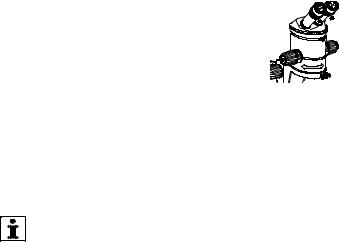
Microscope carrier
Microscope carrier • This microscope carrier permits only
for stereoscopic stereoscopic observation, using both beam paths. observation • The microscope carrier can be fitted to the drive
housing in either of two positions (see page 34):
•The optics carrier can be turned sideways in the microscope carrier if the user needs to work from the side:
Release the clamping screw.
Turn the optics carrier sideways as required.
Retighten the clamping screw.
Microscope carrier AX
The stereomicroscopes can be equipped with the microscope carrier AX for stereoscopic and axial observation instead of the standard microscope carrier (page 34).
Different models are available for MS5, MZ6, MZ75, MZ95 and for MZ125, MZ16 and MZ16 A. The achromatic objectives and the planochromatic 1× fit in the thread in the AX microscope carrier for MS5, MZ6, MZ75, MZ95 (p. 33).
The planochromatic and planapochromatic objectives fit in the thread in the AX microscope carrier for MZ125, MZ16, MZ16 A (p. 33). In addition, the AX microscope carrier features a clamping screw for fixing it in one of 3 positions and an aperture which can be turned manually (see below). Otherwise, the use of and switching to the left, middle and right position are identical.
•The optics carrier cannot be turned sideways in the microscope carrier AX.
Stereoscopic A three-dimensional image is required for examining plastic observation objects and for working.
Shift the stereomicroscope to the central position.
18 |
Leica M Stereomicroscopes – Operation |
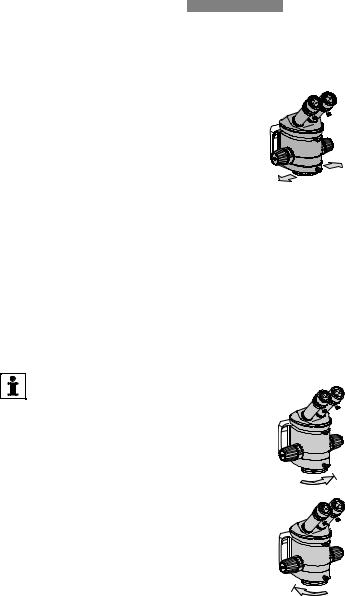
Axial observation
Aperture
The parallax-free imaging produces more precise results in photography, measuring and polarization.
Shift the stereomicroscope to the left or the right position. The object is now located directly beneath either the left or the right beam path.
• When photographing or measuring, select the beam path above which the phototube or measuring graticule is located.
A rotating aperture is build into the AX microscope carrier. It prevents interfering reflections during axial observation with coaxial incident illuminator and quarter-wave plate.
•With the AX microscope carrier for MS5, MZ6, MZ75, MZ95, the aperture automatically turns during the moving process.
•With the AX microscope carrier for MZ125, MZ16, MZ16 A, the aperture is located underneath the microscope carrier and must manually be turned as follows:
Please note:
– In the position for stereoscopic observation through both beam paths, turn the aperture counterclockwise until it stops. Otherwise the field of view is underexposed (vignetting).
– In the position for axial observation through the right or left beam path, turn the aperture clockwise until it stops.
Leica M Stereomicroscopes – Operation |
19 |
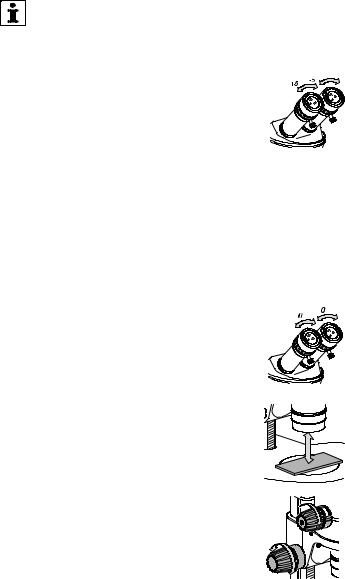
Adjusting diopter settings and parfocality
Tips for your work Leica stereomicroscopes are parfocally matched. This means
that, once you have focused on a feature in the manner described, taking account of diopter settings, you can zoom the magnification up and down without refocusing. You only need to refocus if you want to look at higher or lower planes in the object. A prerequisite is the correct setting of the diopters and the parfocality. 

• The dioptric range is from +5 to –5.
The following adjustments must be carried out only once by each user. The procedures for adjusting the dioptric setting and the parfocality are somewhat different if an eyepiece contains a graticule. Refer to the user manuals for the MPS modular photomicrographic systems or for measuring.
A Preparations Install the lamp.
Set the interpupillary distance and, if necessary, the viewing height.
On the video/phototube: Move the
lever to position "VIS" and open the diaphragm.
Set the double-iris diaphragm to "OPEN."
Adjust the eyecups.
Set both eyepieces to zero.
Set the microscope carrier AX for
stereoscopic observation.
B Focus on the |
1. Place a flat test object under the |
test object |
objective. |
2. Engage the lowest magnification position.
Use the coarse focusing drive to set the working distance (page 16).
3. Look into the eyepieces
Use the focusing drive, to bring the test object into focus.
20 |
Leica M Stereomicroscopes – Operation |

4.Engage the highest magnification position.
5.Optimize the focus using the focusing drive.
C Adjusting |
6. Engage the lowest magnification |
dioptric settings |
position. |
7. Do not look into the eyepieces.
Rotate the eyepieces counterclockwise in the "+" direction as far as the stop (+5 diopters).
8. Look into the eyepieces
Slowly rotate each eyepiece individually in the "–" direction until each eye sees the object sharply imaged.
D Inspecting 9. Engage the highest magnification parfocality position.
10.Refocus if necessary.
11.Slowly move the magnification changer from the lowest magnification to the highest.
•The image sharpness must remain constant (parfocal). Otherwise, repeat the procedure.
Leica M Stereomicroscopes – Operation |
21 |
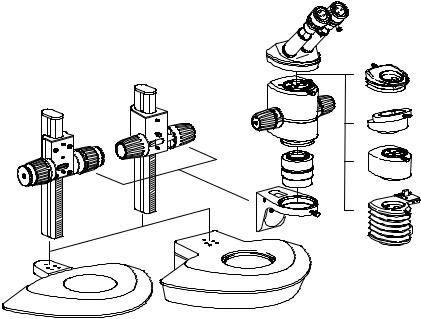
Assembly
The components
1a Incident-light base with stage plate
1b Transmitted-light base with glass stage plate
2a Side-faced column with drive housing, coarse/fine
2b Side-faced column with drive housing, 300 mm or 500 mm
3Microscope carrier
4Optics carrier
5Interchangeable objective
6Binocular tube
7Wide-field eyepiece for spectacle wearers, with eyecups
8Various ErgoModules™ or accessories for video, photography, drawing, fluorescence, coaxial incident light etc.
7
8
6
|
|
4 |
|
|
5 |
|
2b |
3 |
|
|
|
|
2a |
|
1a |
|
1b |
22 |
Leica M Stereomicroscopes – Assembly |
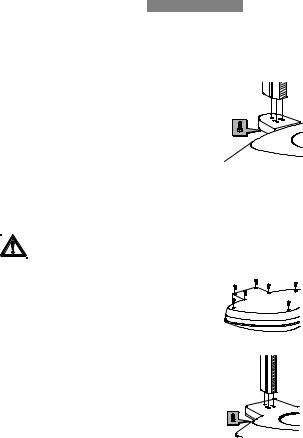
Stand
Incident-light stand
Side-faced column Remove the stage plate.
incident-light base Insert 3 Allen screws into the underside of the baseplate and secure them to the bottom end of the side-faced column.
Insert the stage plate.
|
To fit the microscope carrier and the stereomicroscope, |
|
see page 34 |
|
Transmitted-light stand |
Side-faced column |
Pull the power cable out of the socket in the stand. |
transmitted-light base |
|
Remove the glass stage plate.Carefully invert the transmittedlight base and remove 7 Allen
screws from the base.
Lift off the lower part of the base.
Reverse the upper part of the base.
Insert 3 Allen screws into the cover
plate from beneath and secure them to the bottom end of the sidefaced column.
Replace and secure the base.
Insert the glass stage plate.
Fit the microscope carrier and the stereomicroscope as described on page 34.
Technical data see page 74
Leica M Stereomicroscopes – Assembly |
23 |
